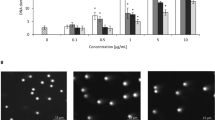Abstract
Efforts to identify an easy and convenient biomarker of carcinogenesis with potentials of application in mass screening program continue. In a series of investigations on mice exposed to different carcinogens, poly-ADP-ribosylation (PAR) of cellular proteins of different tissues has been shown to be a potential biomarker of carcinogenesis. Because blood based biomarker of carcinogenesis offers significant advantage in its use in a cancer screening program, this investigation was undertaken to find correlations between initiation of carcinogenesis and PAR of bone marrow cell (BMC) and blood lymphocyte (BL) proteins in mice chronically exposed to low dose of dimethylnitrosamine (DMN) for up to four weeks in vivo. The exposure was either alone or in combination with 3-aminobenzamide (3-AB), an inhibitor of PAR. Total PAR of cellular proteins and of histone H1 protein were monitored by slot and Western blot immunoprobe assays, respectively. The PAR of total cellular proteins as well as of histone H1 was down-regulated in duration of exposure dependent manners. The results suggest that BMC and BL mirrored status of PAR in other tissues. This finding opens up the possibility of using PAR as a biomarker of carcinogenesis in a blood based test utilizing immunoprobe assay of cellular PAR.
Similar content being viewed by others
Abbreviations
- 3-AB:
-
3-aminobenzamide
- BCIP/NBT:
-
5-bromo-4-chloro-3-indolyl phosphate-nitro blue tetrazolium
- BL:
-
blood lymphocytes
- BMC:
-
bone marrow cells
- DMN:
-
dimethylnitrosamine
- H1:
-
histone H1
- NAD:
-
nicotinamide adenine dinucleotide
- PAb:
-
polyclonal antibodies
- PAR:
-
poly-ADP-ribosylation
- PARP:
-
poly-ADP-ribose polymerase
- PVDF:
-
poly-vinyl dinitrofluoride
- WH:
-
whole homogenate
References
Althaus FR, Richter C: Poly (ADP-ribose) biosynthesis. In: Solioz M (ed). ADP-Ribosylation of Proteins -- Enzymology and Biological Significance: Molecular Biology, Biochemistry and Biophysics. Springer-Verlag, New York, 1987, pp 1–230
Boulikas T: Poly (ADP-ribosylation), DNA strand breaks, chromatin and cancer. Toxicological Letters 67: 129–150, 1993
Miwa M, Sugimura T: ADP-ribosylation and carcinogenesis. In: Moss J and Vaughan M (eds). ADP-ribosylating Toxins and G-proteins: Insights into signal transduction. American Society for Microbiology, Washington DC, 1990, pp 543–560
Pariat T, Sharan RN: Qualitative change in mice liver HMG proteins after low dose chronic administration of aqueous extract of betel nut and diethylnitrosamine. Hepatology Research 12: 177–185, 1998
Saikia JR, Schneeweiss FHA, Sharan RN: Arecoline induced changes of poly-ADP-ribosylation of cellular proteins and its influence on chromatin organization. Cancer Letters 139: 59–65, 1999
Pariat T, Sharan RN: Role of mouse spleen cell HMG proteins and their poly ADP-ribosylation in betel nut induced carcinogenesis. Indian Journal of Biochemistry and Biophysics 39: 130–135, 2002
Kma L, Sharan RN: Negative correlation between poly-ADP-ribosylation of mouse blood lymphocytes proteins and dimethylnitrosamine induced initiation of carcinogenesis as revealed by Slot- and Western blot immunoassays. Proceedings of the National Academy of Sciences, India 73B: 43–51, 2003
Devi BJ, Schneeweiss FHA, Sharan RN: Negative correlation between poly-ADP-ribosylation of spleen cell histone proteins and initial duration of dimethylnitrosamine exposure to mice in vivo measured by Western blot immunoprobe assay: a possible biomarker for cancer detection. Cancer Detection and Prevention 29: 66–71, 2005
Devi BJ, Sharan RN: Progressive reduction in poly-ADP-ribosylation of histone proteins during Dalton's lymphoma induced ascites tumorigenesis in mice. Cancer Letters (in press), 2005 doi:10.1016/j.canlet.2005.07.014.
Sharan RN, Devi BJ, Humtsoe JO, Sailkia JR, Kma L Detection and quantification of poly-ADP-ribosylated cellular proteins of spleen and liver tissues of mice in vivo by slot and Western blot immunoprobing using polyclonal antibody against mouse ADP-ribose polymer. Molecular and Cellular Biochemistry 278: 213–221, 2005
Sharan RN, Devi BJ, Humtsoe JO, Schneeweiss FHA: Immunodetection of cellular poly-ADP-ribosylation. In: Sharan RN (ed). Trends in Radiation and Cancer Biology. Forschungszentrum Juelich GmbH, Germany, International Co-operation Bilateral Seminars Series volume 29, 1998, pp 240–243
Sharan RN: Association of betel nut with carcinogenesis (review). The Cancer Journal 9: 13–19, 1986
Christine MI, Bernard BS: Inhibition of poly (ADP-ribose) synthesis may affect DNA repair prior to ligation. Carcinogenesis 8: 39–43, 1987
Purnell MR, Whish WJD: Novel inhibitors of poly (ADP-ribose) synthetase. Biochemical Journal 185: 775–777, 1980
Pariat T, Sharan RN: Low dose exposure of diethylnitrosamine affects mice liver thymidine kinase. Life Sciences 57: 2431–2437, 1995
Boyum A: Separation of leucocytes from blood and bone marrow. Scandinavian Journal of Clinical Laboratory Investigation 21: 77–89, 1968
Keller SE, Schleifer SJ, McKegney SJ, Camerino M, Stein M: A simplified method for assessing PHA-induced stimulation of rat peripheral blood lymphocytes. Journal of Immunological Methods 51: 287–291, 1982
Rosenberg IM: Antibody preparation. In: Protein Analysis and Purification, Benchtop Techniques, Birkhauser, 1996, pp 370–371
Bradford MM: A rapid and sensitive method for quantification of microgram quantities of proteins using the principle of dye binding. Analytical Biochemistry 72: 248–254, 1976
Boulikas T: Poly (ADP-ribosylated) histones in chromatin replication. Journal of Biological Chemistry 265: 14638–14647, 1990
Millar BC: Cell biology of cancer. In: Horwich A (ed). Oncology -- A Multidisciplinary Text Book. Chapman and Hall, London, 1995
Simbulan-Rosenthal CM, Rosenthal DS, Luo R, Li JH, Zhang J, Smulson ME: Inhibition of poly (ADP-ribose) polymerase activity is insufficient to induce tetraploidy. Nucleic Acids Research 29: 841–849, 2001
Author information
Authors and Affiliations
Corresponding author
Rights and permissions
About this article
Cite this article
Kma, L., Sharan, R.N. In Vivo Exposure of Swiss Albino Mice to Chronic Low Dose of Dimethylnitrosamine (DMN) Lowers Poly-ADP-Ribosylation (PAR) of Bone Marrow Cell and Blood Lymphocyte Proteins. Mol Cell Biochem 288, 143–149 (2006). https://doi.org/10.1007/s11010-006-9130-x
Received:
Accepted:
Published:
Issue Date:
DOI: https://doi.org/10.1007/s11010-006-9130-x




